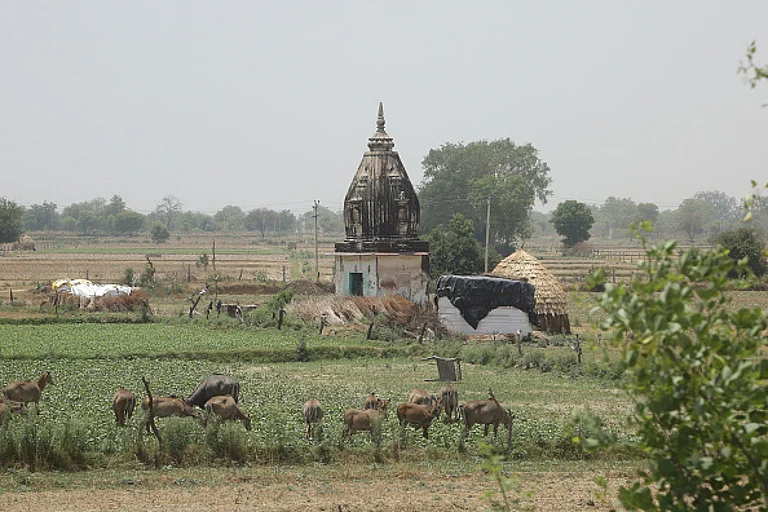As we pass through Fatehganj Poorvi on our way to Budaun district, a peculiar sight catches my attention. A railway crossing comes into view, and we hear a train chugging. We slow down, expecting the barriers to lower, but they don't. Confused, I notice there are no barriers at all.
Panic hits me as I jolt the taxi driver, urging him to stop the passing cars that seem to remain oblivious of the blue-bodied passenger train’s presence. He rolls down the window and frantically points to the train, asking the traffic to stop. Some give him a side-eye, and an e-Rickshaw driver quips, “Naye ho kya bhaiya?,” but no one stops. Ultimately, the train halts about ten steps to our right, traffic remains unaffected. After about two minutes, when the crossing clears, the train departs. Such are the sights of Uttar Pradesh.
As the state that experienced a saffron washover in the previous Lok Sabha elections, with the BJP winning 62 out of 80 seats, I arrived with a certain perception. I expected to see a sea of saffron, a wave of Modi fanatics. However, the festive fervour I anticipated was partially if not wholly absent. Instead, there was a dull, monotonous undertone marked by dust, haze, and scorching heat, with poverty, unemployment, and a serious struggle for survival forming the very backdrop of this inactivity.
During my first phase of ground reporting, I travelled through the constituencies of Budaun, Sambhal and Hathras which went to polls on May 7. Budaun is dominated by Yadavs and Muslims, followed by non-Yadav OBCs. Out of the five legislative assemblies, I chose to visit Sahaswan, the most backward region.
As I entered Budaun, one of my first views was of half-built buildings on either side of the road. On a closer look I realised they were actually half-broken buildings, a signature statement to remind me I was in Yogi Baba’s territory.
Sahaswan as a whole had a lot of problems - unemployment, poverty, lack of access to health care, lack of access to education but even in the remotest of areas, in a village where no one had received education beyond class eight, the level of awareness among the residents, and particularly the women, surprised me. In a discussion about the political scenario in the area, the words “Samvidhan bachana hai” were thrown around several times, a rhetoric popularised by the opposition. When asked where they had heard that one of the old men who could barely sit up on his charpoy pointed to his smartphone, its front and back taped together, “hum phone mein sab dekh lete hain. Humko Dhruv Rathee achha lagta hai,” he says.
A trend I observed during my visit to the three constituencies was that traditional votebanks of both the BJP and the Samajwadi Party largely remained loyal. Upper-caste Hindus continued to support Modi, with only a few disgruntled Thakurs or Baniyas expressing a desire for change, while Yadavs and Muslims remained with the Samajwadi Party. The significant shift was among OBCs and Dalits. Many who previously voted for BJP said they wouldn't do so this time.
And over the course of four days of travel I did not come across anyone who said they had not voted for BJP last time but would do so this time. Despite predictions that the Ram Mandir wave would convert voters to BJP, those who saw the construction as a significant achievement by Modi were already supporters.
In Hathras, the Valmiki community was outraged by the handling of the Hathras gangrape case, where the girl had belonged to their caste. They felt it revealed their true standing in society. In a discussion with residents of Nayee Nagla Valmiki basti, they mentioned that most Valmikis had voted for BJP in 2019 and 2014, hoping for "vikas" (development). Instead, they felt pushed to the brink of survival over the past five years. This time, they were rallying for the INDIA bloc.
Commenting on BJP’s tagline “Beti bachao, beti padhao”, a young man who worked as a cleaner, said, “Na beti ko bacha pa rahe hain, na beti ko padha pa rahe hain.”
While it may seem that the backward castes and classes have united against the saffron party, a political commentator in Hathras reminded me of the presence of the third party—the Bahujan Samaj Party (BSP). He said that the Jatav community, which is in huge numbers in Hathras, has always supported Mayawati and will continue to do so, regardless of her chances of winning. This loyalty means that votes which might have gone to the INDIA bloc will be divided, likely resulting in a BJP victory. He noted that this is the case for most reserved seats in UP, where Mayawati's supporters are substantial and committed to voting for her. So although BSP might be absent from the political discourse, it is very much the kingmaker in the background.
In Sambhal, intriguing Muslim voter dynamics emerged, highlighting questions of loyalty. A decades-long dispute had divided two political families—the Nawabs and the Barqs—both within the Samajwadi Party. This division also split their supporters. With Zia Ur Rehman Barq being fielded from Sambhal, some of Nawab Iqbal Mehmood’s supporters were so averse to him that they considered not voting or supporting a different party. To demonstrate unity, the two leaders publicly reconciled and declared their past differences forgotten.


















